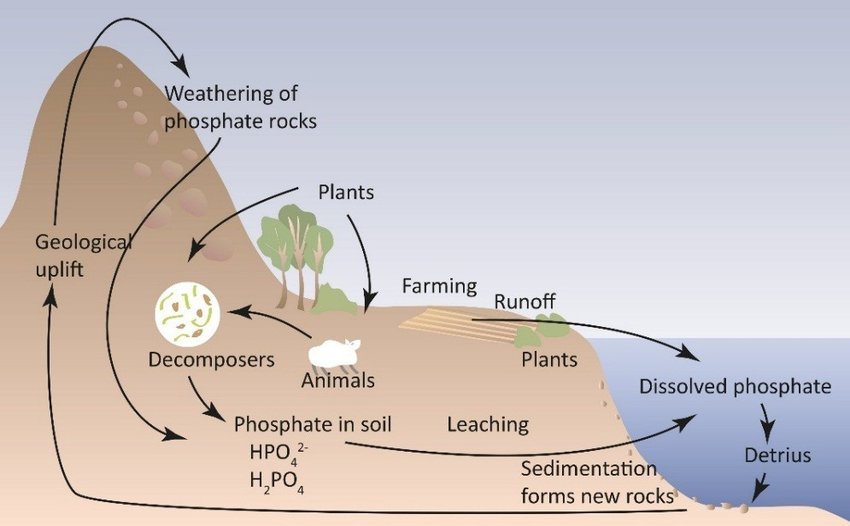
Phosphorus is one of the six main chemical elements of life, along with carbon, hydrogen, nitrogen, oxygen, and sulfur. It forms the structural support backbone of DNA, connecting these molecules’ genetic bases in the familiar double helix. It is vital to both animal metabolism and plant photosynthesis because it is involved in the generation of life’s fundamental fuel, adenosine triphosphate (ATP), the energy that powers growth and movement. Phosphorus is also part of living architecture – it is in the phospholipids that make up the cell walls, as well as the bones and teeth of vertebrates, and the exoskeletons of insects.
Life as we know it requires phosphorus.
The Phosphorous Cycle
Plants and animals normally obtain phosphorus from our environment through what is known as the phosphorus cycle. Unlike some of the other biogeochemical pathways (i.e. the water or hydrologic cycle), the phosphorus cycle is extremely slow. As it is not normally present in a gaseous state, very little phosphorus circulates in the atmosphere. It is highly reactive and never found as a free element on Earth. In minerals, phosphorus generally occurs as phosphate rock. The process by which it moves from deposits on land and in sediments, to living organisms, and then back into the soil and water sediment, quite simply, takes time.
Over many years, rain and weathering cause rocks to release phosphate ions and other minerals. The inorganic phosphate is then distributed in soils and water. Once in the soil and water, plants, fungi, and microorganisms are able to absorb phosphorus and grow. Animals obtain phosphorus from drinking water and eating plants. As do we humans. Phosphorus returns to the cycle via waste and decomposition when plants and animals die. When phosphorus-containing compounds from the bodies or wastes of marine organisms sink to the floor of the ocean, they form new sedimentary layers. This sedimentary rock may be moved from the ocean to the land by a geological process called uplift. However, this process is also very slow, and the average phosphate ion has an oceanic residence time—time in the ocean—of 20,000 to 100,000 years.
Anthropogenic Influence on the Phosphorous Cycle
Approximately 12,000 years ago, our hunter-gatherer ancestors first began farming the land. It is believed that early farmers used manure to fertilize their crops as many as 8,000 years ago. Without understanding the chemistry behind it, they did understand that this addition helped produce higher crop yields. Then, in the 1800s farmers recognized that phosphorus-rich bones and rocks, too, aided in optimal soil output and in 1842, John Bennet Lawes patented a process for treating these new mineral forms of phosphorus with sulfuric acid, making the nutrient more accessible to plants, and soon began selling the world’s first human-made fertilizer.

In just under 2 centuries, the global fertilizer market value has exceeded 155.8 billion USD.
Now, the vast majority of phosphorus compounds mined are consumed as fertilizers—up to 90% of all mined rock, in fact. Nearly all of the phosphorus that farmers use today—and that we consume in the food we eat—is mined from just a few sources of phosphate rock, mainly in the United States, China, and Morocco. However, it’s important to note that phosphate rock is a non-renewable resource that took 10-15 million years to form from seabed to soil via tectonic uplift and weathering. New research even suggests that phosphorus itself was actually transported to Earth via comets.
Indications are that phosphorus demand could outstrip supply this century if no fundamental changes are made to the current trajectory of use. By some estimates, phosphate reserves could run out in as little as 50 to 100 years. Geologists know of other deposits, but they are harder to access and contain less phosphorus. Thus, the market price will likely rise, making it harder for growers to afford fertilizer and ultimately, for people to afford food. While oil and other non-renewable natural resources can be substituted with other sources when they peak (like wind, biomass or thermal energy), phosphorus has no substitute in food production. And according to estimates compiled by the Food and Agriculture Organization, by 2050 we will need to produce 60% more food to feed a world population of 9.3 billion people.
The Future
Sustainability is defined as the avoidance of the depletion of natural resources in order to maintain an ecological balance that supports all life on Earth. Our current use of phosphorus is anything but sustainable. One of the major inefficiencies of modern fertilizer use is the tendency to use more and more in the face of substandard yields—despite there being no corresponding increase in food production. Additionally, it has been shown that phosphorus actually collects in the soil in a form inaccessible to plant life. This excess phosphorus passes to our rivers, lakes and oceans via runoff where it can cause toxic algal blooms – from the Baltic Sea, to China to the Great Lakes of North America to Australia’s Great Barrier Reef. Algal blooms and eutrophication can kill fish and other aquatic life from oxygen depletion, pollute our drinking water, and damage our tourism and fishing industries.
Phosphorus is scarce not only because it is finite, but because it is mismanaged in the food system. Only one-fifth of the phosphate mined specifically for food production ends up in the food we eat globally. Four-fifths of the phosphorus is lost or wasted during mining and processing, fertilizer production and distribution, fertilizer application on farms, food production and trade, right through to the dinner table—Americans waste as much as 1 pound of food per person per day. By fighting food loss and waste; improving mining efficiency and farming practices; preventing fertilizer runoff; capturing waste for reuse as fertilizer to rebalance the natural phosphorus cycle; and working on increased phosphorus recycling–unlike many of our non-renewable resources, phosphorus is recoverable and reusable if present in sufficient concentrations–we can sustain global food production and life on Earth into the future.





Pingback:Countdown with the Hive to a New Year – swrm